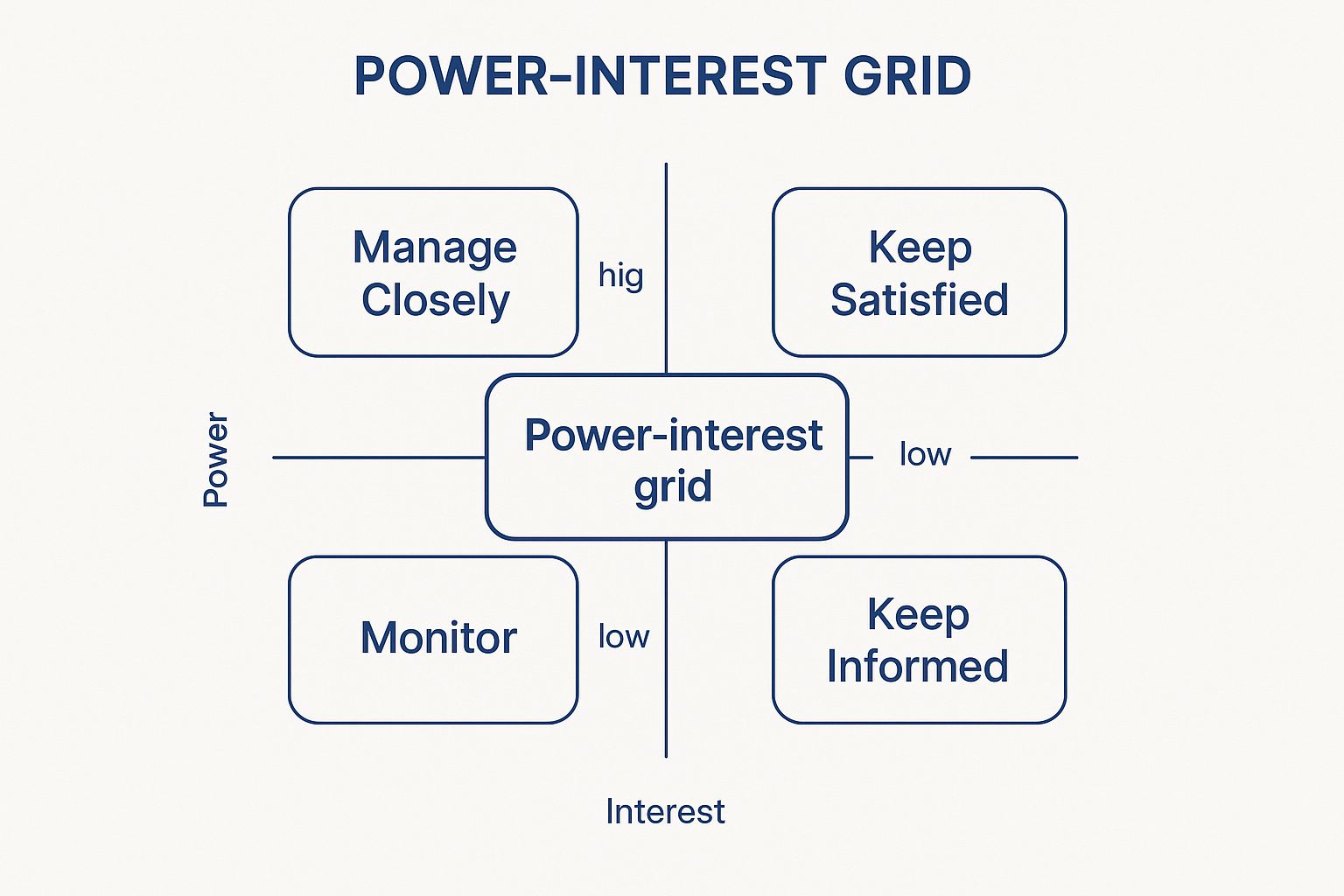Stakeholder management is often treated as a project management checkbox, a simple task of identifying who's involved. But in today's interconnected environment, this passive approach is a recipe for stalled projects, misaligned goals, and missed opportunities. True success hinges on dynamic, proactive stakeholder management strategies that transform relationships from transactional to collaborative. It's about more than just keeping people happy; it's about building a coalition of engaged partners invested in a shared vision.
When feedback loops break down, leading to endless email chains, conflicting annotations on outdated files, and a tangled mess of spreadsheets, the entire project is at risk. This communication breakdown isn't just an inconvenience; it's a critical failure point that can derail even the most well-conceived plans. Effective strategies are built on a foundation of clear communication, mutual trust, and a deep understanding of each stakeholder's power, interest, and perspective.
This guide moves beyond generic advice to provide a curated roundup of seven powerful, actionable strategies. Each one is a proven framework designed to help you navigate complex relationships, foster genuine buy-in, and drive your projects toward a successful, mutually beneficial conclusion. We'll explore how to implement these strategies and how modern tools can streamline the critical feedback and review cycles that underpin them.
1. Stakeholder Mapping and Power-Interest Grid
Not all stakeholders are created equal. Trying to give everyone the same level of attention is a fast track to burnout and ineffective communication. This is where stakeholder mapping, specifically using a Power-Interest Grid, becomes one of the most foundational stakeholder management strategies. It’s a visual framework for categorizing stakeholders based on their level of influence (power) and how much they care about your project (interest).
This strategic classification allows you to move beyond a one-size-fits-all approach and allocate your time and resources with precision. For instance, a software company launching a new feature would map key investors (High Power/High Interest) differently than casual beta testers (Low Power/High Interest). The investors need close management, while the testers need to be kept informed.
How to Implement a Power-Interest Grid
The grid is divided into four quadrants, each dictating a specific engagement strategy:
- High Power, High Interest (Manage Closely): These are your key players. Fully engage with them, collaborate closely, and make the greatest effort to satisfy their needs.
- High Power, Low Interest (Keep Satisfied): These stakeholders have significant influence but aren't deeply involved in daily details. Keep them happy and satisfied, but avoid overwhelming them with excessive information.
- Low Power, High Interest (Keep Informed): This group is passionate about the project but lacks significant power. Keep them adequately informed and consult them on their areas of interest to leverage their support.
- Low Power, Low Interest (Monitor): These stakeholders require minimal effort. Monitor them for any shifts in their power or interest, but don’t bog them down with unnecessary communications.
This concept map visualizes how the two core axes of Power and Interest intersect to create four distinct stakeholder engagement quadrants.

By plotting each stakeholder on this grid, you create a clear roadmap for prioritizing communication and engagement efforts.
Pro-Tips for Effective Mapping
To get the most out of your Power-Interest Grid, remember to involve multiple team members to get diverse perspectives and reduce bias. Update the grid regularly, as a stakeholder’s influence or interest can change overnight. Most importantly, validate your assumptions. Your assessment of a stakeholder's power is a hypothesis until confirmed through direct interaction and feedback.
2. Regular Communication and Transparent Reporting
Once you've mapped your stakeholders, the next critical step is establishing a rhythm of consistent, open, and honest dialogue. This isn't about spamming inboxes; it's a systematic approach to building trust through scheduled updates and proactive information sharing. This is one of the most effective stakeholder management strategies because it manages expectations, prevents surprises, and transforms stakeholders from passive observers into engaged partners.
Transparent reporting means sharing both the wins and the setbacks. When stakeholders like Patagonia's customers see detailed environmental impact reports, or when Microsoft's developer community receives regular, candid updates, it fosters deep-seated loyalty. This approach demonstrates respect for their investment, whether that investment is financial capital or simply their time and feedback.

How to Implement a Transparent Communication Cadence
A cornerstone of effective stakeholder engagement is a well-structured stakeholder communication plan. This plan defines the what, when, and how of your interactions, ensuring no one is left in the dark.
- Set a Regular Schedule: Establish a predictable cadence for updates, such as weekly email summaries, bi-weekly progress meetings, or monthly newsletters. Consistency is key.
- Use a Multi-Channel Approach: Combine different formats to suit various preferences. Use email for formal reports, a Slack channel for quick updates, and video calls for in-depth discussions.
- Be Proactive with Bad News: Don't wait for stakeholders to discover problems. Addressing issues head-on, along with a proposed solution, builds credibility and shows you are in control.
- Centralize Information: Create a single source of truth, like a project dashboard or a shared document, where stakeholders can access the latest information on their own time.
This disciplined approach ensures that communication is not an afterthought but a core component of your project management discipline. Learn more about developing these high-impact stakeholder communication strategies to keep everyone aligned and informed.
Pro-Tips for Effective Reporting
To elevate your communication, focus on clarity and relevance. Tailor the level of detail and frequency to each stakeholder group identified in your power-interest grid. Use visual aids like charts and dashboards to make complex data easily digestible. Finally, always include a feedback loop, such as a quick survey or a dedicated Q&A session, to measure the effectiveness of your communication and make continuous improvements.
3. Collaborative Decision-Making and Co-creation
Moving beyond simply managing stakeholders, this strategy transforms them into active partners. Collaborative decision-making and co-creation involve stakeholders directly in problem-solving and solution development. This approach treats stakeholders as valuable contributors, leveraging their diverse expertise and perspectives to build more robust, well-supported outcomes. It's one of the most powerful stakeholder management strategies for fostering deep buy-in and shared ownership.
Instead of presenting finished plans for approval, you build them together. For example, LEGO’s Ideas platform allows fans to submit and vote on new product designs, directly co-creating the next generation of toys. This method ensures the final product is aligned with market desires from the very beginning, turning passive consumers into committed brand evangelists.

How to Implement Collaborative Co-creation
Implementing this strategy requires a structured yet flexible approach to ensure all voices are heard and channeled productively. It's about creating a space for genuine partnership rather than just another meeting.
- Define Clear Roles & Authority: Before you begin, clarify who makes the final decision. Is the group's input a recommendation or a binding vote? Setting these boundaries prevents confusion and manages expectations.
- Use Structured Facilitation: Employ techniques like design thinking workshops or structured brainstorming sessions to guide the conversation. A skilled facilitator can manage dominant personalities and ensure quieter stakeholders have a chance to contribute. For insights on structuring these sessions, you can learn more about team collaboration strategies on bugsmash.io.
- Document Everything: Record all ideas, perspectives, and the rationale behind final decisions. This transparency builds trust and provides a valuable reference for future project phases. Platforms like BugSmash can be instrumental here, creating a central repository for feedback and decisions.
- Celebrate Successes: Acknowledge and celebrate the milestones achieved through collaboration. This reinforces the value of the approach and encourages continued participation from everyone involved.
Pro-Tips for Effective Co-creation
To make collaboration truly effective, you must establish a foundation of trust and clear communication. Ensure the process is more than just performative; it needs to have a real impact on the project's direction. Set realistic timelines that account for the extra time collaboration requires. Most importantly, ensure the right people are in the room. Involving a cross-functional group that represents different facets of the project will yield far richer insights and more innovative solutions.
4. Proactive Issue and Risk Management
The best way to handle a stakeholder crisis is to prevent it from ever happening. Waiting for problems to erupt before you address them is a reactive stance that erodes trust and derails projects. A proactive issue and risk management approach is one of the most powerful stakeholder management strategies because it focuses on identifying and mitigating potential conflicts before they escalate. This forward-looking mindset keeps you in control, rather than letting events control you.
This strategy involves continuously scanning the project environment for potential threats, establishing early warning systems, and having a response plan ready. For example, a tech company planning a major user interface overhaul can anticipate user backlash by proactively communicating the changes, providing tutorials, and setting up dedicated feedback channels. This transforms a potential crisis into an opportunity for engagement and improvement.
How to Implement Proactive Risk Management
Effective implementation requires a structured, system-wide approach to anticipating challenges:
- Continuous Scanning: Regularly monitor social media, industry news, and internal feedback channels for early warning signs of stakeholder dissatisfaction or emerging risks.
- Risk Assessment Workshops: Bring together diverse team members, from developers to marketers, to brainstorm potential issues. What could go wrong? Which stakeholders would be most affected?
- Scenario Planning: For high-probability, high-impact risks, develop detailed response plans. For instance, what is the exact communication protocol if a major service outage occurs? Who needs to be informed, and in what order?
- Rapid Response: Create clear escalation paths and pre-approved communication templates. This ensures that when an issue does arise, your team can respond swiftly, consistently, and effectively without delay.
By formalizing this process, you build organizational resilience and maintain stakeholder confidence, even when faced with unexpected challenges. This commitment to foresight is a key part of continuous quality assurance process improvement.
Pro-Tips for Effective Implementation
To embed proactivity into your team's culture, focus on preparation and practice:
- Establish clear thresholds for when an issue needs to be escalated. Not every complaint requires a CEO-level response.
- Conduct regular simulation exercises. Practicing your response to a mock crisis is the best way to find gaps in your plan before you face a real one.
- Keep your risk register dynamic. This isn't a one-time document; it should be reviewed and updated at every major project milestone.
- Empower front-line team members to flag potential issues without fear of blame. A culture of psychological safety is crucial for early detection.
5. Value Alignment and Mutual Benefit Creation
Effective stakeholder engagement moves beyond transactional exchanges and into the realm of true partnership. Value alignment and mutual benefit creation is one of the most powerful stakeholder management strategies because it focuses on identifying and leveraging shared goals between your organization and its stakeholders. The core idea, popularized by Michael Porter and Mark Kramer's "Shared Value" concept, is that corporate success and social well-being are interdependent.
This approach transforms the dynamic from a zero-sum game into a collaborative effort for mutual success. For example, instead of just negotiating prices, a company like Starbucks partners with coffee farmers to ensure sustainable sourcing and community development. This creates a resilient supply chain (company win) and provides economic stability for the farmers (stakeholder win), forging a long-term, trust-based relationship.
How to Implement Value Alignment
Creating shared value requires a deliberate shift in perspective, moving from a narrow economic focus to a broader view of value creation.
- Conduct Value Mapping: Start by mapping your stakeholders' core values, needs, and interests. Compare these against your own organizational goals to find areas of natural overlap and potential for shared benefit.
- Launch Pilot Projects: Begin with small, targeted initiatives to demonstrate the "win-win" potential. A successful pilot can build momentum and provide a compelling case for broader implementation.
- Communicate Value Stories: Share the successes of your initiatives. Highlighting how both the organization and its stakeholders are benefiting reinforces the partnership and encourages deeper engagement.
- Measure Shared Outcomes: Develop metrics to track the value created for both your business and your stakeholders. This provides tangible proof of the strategy's effectiveness and helps guide future efforts.
This strategy is particularly effective for building long-term resilience and a strong brand reputation, turning stakeholders into loyal advocates.
Pro-Tips for Creating Mutual Benefit
To truly embed this strategy, regularly reassess and realign values, as business needs and stakeholder priorities can evolve. Involve stakeholders directly in brainstorming sessions to co-create value initiatives; this ensures buy-in and leads to more innovative solutions. Finally, make shared value a core component of your strategic planning, not an isolated CSR activity.
6. Segmented Engagement Strategies
Treating every stakeholder group the same way is a recipe for missed opportunities and miscommunication. Segmented engagement strategies move beyond broad-strokes communication by recognizing that different groups have unique needs, communication preferences, and expectations. This approach involves tailoring your interactions for each specific stakeholder segment.
Originating from principles in marketing and customer relationship management, this strategy applies segmentation to the entire stakeholder ecosystem. For example, a pharmaceutical company must engage with patients, healthcare providers, and regulators. Each group requires vastly different messaging, channels, and levels of detail. A one-size-fits-all newsletter simply won’t cut it. This targeted approach ensures that your communication is relevant, respectful, and effective, which is a cornerstone of advanced stakeholder management.
How to Implement a Segmented Approach
Developing a segmented strategy requires a deep understanding of your stakeholder landscape. Start by grouping stakeholders based on meaningful criteria beyond just their power and interest levels.
- Group by Function: Separate stakeholders by their role (e.g., developers, investors, end-users, marketing team).
- Group by Communication Preference: Some stakeholders prefer detailed email reports, others want quick Slack updates, and some need face-to-face meetings.
- Group by Impact: Categorize them based on how project outcomes will directly affect them (e.g., their daily workflow, financial returns, or regulatory compliance).
A university, for instance, communicates with students about campus life and course schedules, while it engages alumni with fundraising campaigns and networking events. These are two distinct segments with different needs, requiring tailored engagement plans.
Pro-Tips for Effective Segmentation
To master this nuanced strategy, you need to be data-driven and adaptable. A static segmentation model will quickly become obsolete.
First, create detailed stakeholder personas for your most critical segments. These fictional profiles, complete with goals, pain points, and communication habits, will help your team empathize with and effectively engage each group. Next, establish segment-specific key performance indicators (KPIs) to measure the success of your engagement. Finally, continuously solicit feedback and be prepared to refine your segments and strategies as the project evolves and new information comes to light.
7. Digital Engagement and Technology Integration
In today's hyper-connected world, relying solely on face-to-face meetings and email chains is a missed opportunity. Integrating digital tools and technology into your communication plan is a modern stakeholder management strategy that boosts efficiency, expands reach, and personalizes engagement. This approach uses everything from social media and mobile apps to dedicated stakeholder portals to create more interactive and accessible communication channels.
This strategy is about meeting stakeholders where they are: online. For example, a government agency developing new public policy can use an online consultation platform to gather feedback from thousands of citizens, a far more scalable approach than traditional town halls. Similarly, Tesla’s use of social media for direct customer communication and over-the-air software updates creates a powerful, continuous feedback loop that keeps users engaged and invested in the brand’s evolution.
How to Implement Digital Engagement Strategies
Leveraging technology effectively requires more than just creating a social media account. It's about building a digital ecosystem for your stakeholders:
- Establish a Centralized Hub: Create a dedicated online portal or use a CRM system to manage communications, share documents, and track interactions. This ensures a single source of truth for all stakeholder information.
- Utilize Interactive Platforms: Employ virtual collaboration tools like Miro or Mural for brainstorming sessions and use platforms like social media or specialized apps for real-time updates and feedback collection.
- Leverage Data and Analytics: Use analytics from your digital platforms to understand stakeholder behavior, measure engagement levels, and refine your communication tactics. This data-driven approach helps you focus your efforts where they matter most.
- Personalize Communication at Scale: Use marketing automation and CRM tools to send targeted, personalized messages to different stakeholder segments, ensuring the right information reaches the right people without manual effort.
Key Insight: Digital transformation is not just about adopting new tools; it's about fundamentally changing how you interact with and understand your stakeholders, making the process more dynamic, data-informed, and responsive.
Pro-Tips for Effective Digital Integration
To maximize the impact of your digital engagement, focus on user experience and strategic implementation. Always ensure your digital tools are user-friendly, mobile-optimized, and secure, especially when handling sensitive data.
Remember that technology should augment, not replace, human connection. Use digital platforms to facilitate dialogue and gather broad feedback, but reserve high-stakes conversations for more personal channels. Finally, provide multiple digital and non-digital options to accommodate varying levels of tech-savviness among your stakeholders, ensuring no one is left behind.
Stakeholder Management Strategies Comparison
| Strategy | Implementation Complexity 🔄 | Resource Requirements ⚡ | Expected Outcomes 📊 | Ideal Use Cases 💡 | Key Advantages ⭐ |
|---|---|---|---|---|---|
| Stakeholder Mapping and Power-Interest Grid | Low to Moderate: Simple framework but needs updates | Low: Mainly requires stakeholder input | Clear prioritization of stakeholders | Projects needing stakeholder prioritization | Easy to use; optimizes engagement resources; identifies key decision makers |
| Regular Communication and Transparent Reporting | Moderate to High: Requires consistent effort and coordination | High: Requires ongoing communication resources | Builds trust; reduces misinformation | Organizations emphasizing transparency | Builds credibility; improves buy-in; enables early issue detection |
| Collaborative Decision-Making and Co-creation | High: Complex facilitation and consensus building | High: Time and skilled facilitation needed | Increased buy-in; better quality solutions | Initiatives requiring stakeholder involvement | Enhances commitment; leverages diverse expertise; builds strong relationships |
| Proactive Issue and Risk Management | Moderate to High: Needs specialized skills and protocols | Moderate to High: Investment in monitoring tools | Minimizes crises; maintains trust | High-risk environments needing early warnings | Prevents escalation; demonstrates competence; strategic preparedness |
| Value Alignment and Mutual Benefit Creation | High: Deep analysis and long-term alignment required | Moderate to High: Continuous engagement efforts | Sustainable partnerships; shared success | Long-term strategic partnerships | Creates mutual value; reduces conflicts; increases loyalty |
| Segmented Engagement Strategies | High: Requires detailed segment analysis and customization | High: Multiple tailored approaches needed | More relevant engagement; better feedback | Diverse stakeholder groups with varying needs | Improves satisfaction; efficient resource use; targeted communication |
| Digital Engagement and Technology Integration | Moderate to High: Needs technology tools and ongoing updates | Moderate to High: Investment in digital platforms | Increased accessibility; real-time interaction | Organizations leveraging digital platforms | Scalable; enhances data insights; provides convenience |
From Strategy to Action: Unifying Your Stakeholder Engagement
Mastering the art of stakeholder management is no longer a soft skill; it's a strategic imperative that separates successful projects from those that merely stumble across the finish line. The strategies we've explored, from meticulous stakeholder mapping to proactive risk management and collaborative co-creation, provide a robust framework for transforming relationships from transactional to truly collaborative partnerships. Moving beyond generic advice means embracing these dynamic approaches as interconnected parts of a unified whole.
The core lesson is this: effective stakeholder management strategies require more than just a plan. They demand a system. The true challenge lies not in identifying what to do, but in executing it consistently and efficiently. Whether you are segmenting communication for different stakeholder groups or seeking transparent feedback, the process hinges on clear, frictionless interaction. Without the right operational backbone, even the best-laid plans can collapse under the weight of administrative chaos, scattered feedback, and missed signals.
Bridging the Gap Between Theory and Execution
The transition from strategic theory to successful practice is where most teams falter. You can create the most detailed Power-Interest Grid, but its value diminishes if your communication with high-power stakeholders is delayed by inefficient feedback cycles. You can champion collaborative decision-making, but it will fail if stakeholders find it too cumbersome to provide their input on key assets like design mocks, videos, or marketing materials.
This operational friction is the silent killer of project momentum and stakeholder goodwill. The solution is to centralize and streamline the most critical point of interaction: the feedback loop. For a holistic approach to stakeholder engagement that ensures lasting impact, a crucial step is learning how to build a customer success strategy for long-term growth, as many of the same principles of value creation and proactive communication apply directly to your internal and external partners. By focusing on a seamless experience, you empower stakeholders to become active, engaged partners rather than passive observers.
Unifying Your Efforts for Maximum Impact
Ultimately, a sophisticated stakeholder management strategy is an ecosystem, not a checklist. Each element, from aligning on mutual value to integrating digital tools, reinforces the others. By implementing these strategies, you are not just managing expectations; you are building a coalition of advocates for your project's success. You move from a defensive, reactive posture to one of confident, proactive leadership. This shift empowers your team to focus on innovation and value delivery, secure in the knowledge that your stakeholder relationships are built on a foundation of clarity, trust, and shared purpose.
Ready to eliminate feedback chaos and supercharge your stakeholder management strategies? BugSmash centralizes feedback on all your digital assets, from websites and PDFs to images and videos, into one organized platform. Try BugSmash today and transform your collaborative process from frustrating to seamless.




